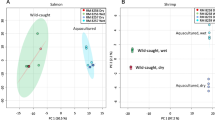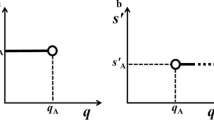Abstract
Biological reference materials (RMs) are essential for quality assurance, traceability of measurement results and for method validation. When addressing new measurement questions or emerging regulatory issues, rigorous large-scale CRM production may not be time efficient or economically practical using current production methods. By amending a relatively small matrix batch with a compound(s) of interest at the homogenization step, the National Institute of Standards and Technology (NIST) can create a custom material on an “as-needed” basis and circumvent the time delay inherent in large-batch production, thereby generating a fit-for-purpose, rapid-response RM. Here, Coho salmon (Oncorhynchus kisutch) was cryohomogenized and spiked with an aquaculture antibiotic and antibiotic metabolite. The resultant material was analyzed using liquid chromatography-high resolution tandem mass spectrometry (LC-HRMS/MS) to determine the effectiveness of the amendment technique in a fresh-frozen matrix by assessing homogeneity and accuracy to the target concentration (e.g. mass fraction). Target mass fractions were achieved for both spike components, with RSDs below 5% in replicate measurements of each compound (n = 8). The stability of the spiked compounds was assessed one year post-production and mass fractions were stable, within 1–6% of the initial measurement results, indicating minimal change to the amended analyte concentrations over time. The results support this method as a promising new technique for custom, small-batch RM generation.

Similar content being viewed by others

References
ISO GUIDE 30:2015(E): Reference materials — Selected terms and definitions (2015).
Point D, Davis WC, Alonso JIG, Monperrus M, Christopher SJ, Donard OFX, et al. Simultaneous determination of inorganic mercury, methylmercury, and total mercury concentrations in cryogenic fresh-frozen and freeze-dried biological reference materials. Anal Bioanal Chem. 2007;389(3):787–98. https://doi.org/10.1007/s00216-007-1516-4.
Grimalt S, Harbeck S, Shegunova P, Seghers J, Sejeroe-Olsen B, Emteborg H, et al. Development of a new cucumber reference material for pesticide residue analysis: feasibility study for material processing, homogeneity and stability assessment. Anal Bioanal Chem. 2015;407(11):3083–91. https://doi.org/10.1007/s00216-015-8476-x.
Phillips MM, Seal TML, Ness JM, Zhang K. Development and characterization of a Multimycotoxin reference material. J AOAC Int. 2019;102(6):1642–50. https://doi.org/10.5740/jaoacint.19-0109.
Zeleny R, Emteborg H, Charoud-Got J, Schimmel H, Nia Y, Mutel I, et al. Development of a reference material for Staphylococcus aureus enterotoxin a in cheese: feasibility study, processing, homogeneity and stability assessment. Food Chem. 2015;168:241–6. https://doi.org/10.1016/j.foodchem.2014.07.066.
Wise SA, Benner BA, Christensen RG, Koster BJ, Kurz J, Schantz MM, et al. Preparation and analysis of a frozen mussel tissue reference material for the determination of trace organic constituents. Environ Sci Technol. 1991;25(10):1695–704. https://doi.org/10.1021/es00022a003.
Manning L, Soon JM. Food safety, food fraud, and food defense: a fast evolving literature. J Food Sci. 2016;81(4):R823–34. https://doi.org/10.1111/1750-3841.13256.
Littlefield NA, Gaylor DW, Blackwell BN, Allen RR. Chronic toxicity carcinogenicity studies of genetian violet in Fischer-344 rats −2 generation exposure. Food Chem Toxicol. 1989;27(4):239–47. https://doi.org/10.1016/0278-6915(89)90162-2.
Srivastava S, Sinha R, Roy D. Toxicological effects of malachite green. Aqua Tox. 2004;66(3):319–29. https://doi.org/10.1016/j.aquatox.2003.09.008.
Hall Z, Hopley C, O'Connor G. High accuracy determination of malachite green and leucomalachite green in salmon tissue by exact matching isotope dilution mass spectrometry. J Chromatogr B. 2008;874(1–2):95–100. https://doi.org/10.1016/j.jchromb.2008.09.006.
Schneider MJ, Andersen WC. Determination of Triphenylmethane dyes and their metabolites in Salmon, catfish, and shrimp by LC-MS/MS using AOAC first action method 2012.25: collaborative study. J AOAC Int. 2015;98(3):658–70. https://doi.org/10.5740/jaoacint.14-263.
Zeisler R, Langland JK, Harrison SH. Cryogenic homogenization of biological tissues. Anal Chem. 1983;55(14):2431–4. https://doi.org/10.1021/ac00264a055.
Linsinger T. Comparison of a measurement result with the certified value European Reference Materials Application Note. 2005:1 https://ec.europa.eu/jrc/en/reference-materials/application-notes.
Acknowledgments
The authors would like to thank the manuscript reviewers for their thoughtful comments, Piper Schwenke of the National Oceanic and Atmospheric Administration Northwest Fisheries Science Center Forensic Laboratory for help in procuring the salmon and the NIST Biorepository team for their assistance in processing the bulk salmon tissue.
Author information
Authors and Affiliations
Corresponding author
Ethics declarations
Conflict of interest
The authors declare that they have no conflict of interest.
Disclaimer
Official contribution of the National Institute of Standards and Technology. Not subject to copyright in the United States. Certain commercial equipment, instruments, software or materials are identified in this document. Such identification does not imply recommendation or endorsement by the National Institute of Standards and Technology, nor does it imply that the products identified are necessarily the best available for the purpose.
Additional information
Publisher’s note
Springer Nature remains neutral with regard to jurisdictional claims in published maps and institutional affiliations.
Rights and permissions
About this article
Cite this article
Ellisor, D.L., Davis, W.C. & Pugh, R.S. Spiking and homogenization of biological matrices for production of reference materials using cryogenic processes. Anal Bioanal Chem 412, 5447–5451 (2020). https://doi.org/10.1007/s00216-020-02761-y
Received:
Revised:
Accepted:
Published:
Issue Date:
DOI: https://doi.org/10.1007/s00216-020-02761-y



